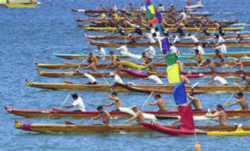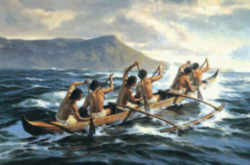
Hawaii Symbols
Hawaii State Team Sports
Outrigger Canoe Paddling

Adopted in 1986
Statute
Hawaii designated outrigger canoe paddling as the official state team sport in 1998 (surfing was adopted as the official Hawaii individual sport in 1986).
Outrigger canoe paddling is an essential part of Polynesian culture and for Ancient Hawaiians the canoe literally represented 'life' since it provided
both food & transportation for their families.
Canoe racing & surfing were ways for Hawaiians to hone their skills in the ocean. Outrigger canoe paddling first became a sport in the early 1800′s
but was then outlawed by the missionaries in 1820 & not 'officially' reinstated again until 1976. Today the sport is growing and crews of paddlers
from ages 7-70 yrs old paddle in regattas hosted throughout the Spring & Summer. Each canoe has 6 paddlers- a stroker to set the pace & a steersman
to maneuver the boat.
Outrigger canoes were traditionally made of Koa wood but today more modern materials are used to create lighter canoes which are faster for racing.
However, during all 'State Championship' races crews are required to paddle in a Koa canoe to maintain the tradition. Simply by paddling 'canoes' we
help to perpetuate the culture of the islands and Polynesian people.
Hawaii State Team Sports:
Outrigger canoe paddling
Historical Significance

Outrigger canoes
first arrived in Hawaii around 200 AD, some large enough to hold up to 80 people, and were filled with essential items like edible plants, water and
animals to ensure a somewhat safer voyage for the brave explorers who took off in search of land. By following the migration patterns of birds seen
flying overhead, explorers soon discovered the Hawaiian Islands.
The harsh terrain of the land, including jagged volcanic lava rock, steep cliffs, howling wind and waves, made it very difficult to transport anything,
so outrigger canoes became a necessity for tasks like fishing and transporting goods and people. When native Hawaiians found giant Koa trees on the
Big Island, they soon discovered they could build an entire canoe hull from a single piece of wood. While the outrigger canoe has gone through many
phases over the last 2,000 years, Hawaiian outrigger canoes specifically remain built for battling conditions in the open ocean and are recognized
for their unique shape, design and lack of extra ornamentation or decoration.
Since setting out on the ocean was still a very dangerous and risky task, building a new canoe involved the work and dedication of many people as well
as frequent cultural and traditional practices. First, a kahuna, or Hawaiian priest, had to search for the perfect site and tree by following the 'elepaio,
or Hawaiian forest bird, into the forest. Since the 'elepaio was attracted to rotting Koa wood, if the bird began pecking at the tree, that meant the
wood was not solid and the tree would be useless for the strong structure it took to build a canoe. Once finding the perfect tree, the kahuna would
then gather the canoe builders and workers, staying throughout the building process to offer prayers and blessings.
Once the tree was transported back to shore, which often required the effort of hundreds of men over several days, the hull was finished in a special
halau, or canoe shed. One of the most highly honored members of the ancient Hawaiian society was the canoe carver, or kalai wa'a. Black paint, made
from a mixture of plants and charcoal, was then added to the outer layer of the canoe to help keep it waterproof. For the Ali'i, or royalty, hens'
eggs were used to make the paint shiny and glossy. The final act of building the canoe was the sacrifice of a dog and pig, which symbolized the tearing
apart of the billows of the ocean and the rooting of the canoe into the open sea, respectively. Noho, or canoe seats, were often named after the paddler
instead of the position number, and specialized wood artisans were given the task of making the paddles, all of which were customized for each owner
and displayed proudly inside the paddler's home.
Hawaii Law
The law designating the outrigger canoe paddling as the official Hawaii state team sport is found in the Hawai`i Revised Statutes, Volume 1, Chapter 5, Section 5-14
Volume 1.
CHAPTER 5. EMBLEMS AND SYMBOLS.
SECTION 5-14
[§5-14] State team sport. Outrigger canoe paddling is adopted, established, and designated as the official team sport of the State, to be effective
for as long as the legislature of the State does not otherwise provide. [L 1986, c 219, §2]







